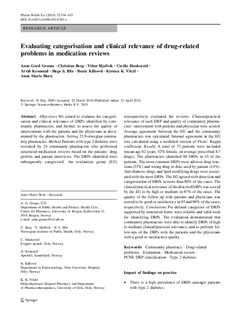| dc.contributor.author | Granås, Anne Gerd | |
| dc.contributor.author | Berg, Christian | |
| dc.contributor.author | Hjellvik, Vidar | |
| dc.contributor.author | Haukereid, Cecilie | |
| dc.contributor.author | Kronstad, Arvid | |
| dc.contributor.author | Blix, Hege Salvesen | |
| dc.contributor.author | Kilhovd, Bente | |
| dc.contributor.author | Viktil, Kirsten K. | |
| dc.contributor.author | Horn, Anne Marie | |
| dc.date.accessioned | 2017-06-07T12:41:15Z | |
| dc.date.available | 2017-06-07T12:41:15Z | |
| dc.date.issued | 2010 | |
| dc.identifier.citation | Granas, A.G., Berg. C., Hjellvik, V., Haukereid, C., Kronstad, A., Blix, H.S., Kilhovd, B., Viktil, K.K. & Horn, A.M. (2010) Evaluating categorization and clinical relevance of drug-related problems in medication reviews. Pharmacy World & Science, 32(3), s. 394-403. | |
| dc.identifier.uri | http://hdl.handle.net/11250/2445226 | |
| dc.description | Beskriver en intervensjonsstudie hvor hensikten var å evaluere kategorisering og klinisk relevans av legemiddelrelaterte problem identifisert av kommune-farmasøyter, og vurdere kvaliteten på intervensjoner med pasienter og leger som dokumentert av farmasøyter. | |
| dc.description.abstract | Objectives: we aimed to evaluate the categorisation and clinical relevance of DRPs identified by community pharmacists, and further, to assess the quality of interventions with the patients and the physicians as documented by the pharmacists. Setting 23 Norwegian community pharmacies. Method: patients with type 2 diabetes were recruited by 24 community pharmacists who performed structured medication reviews based on the patients’ drug profiles and patient interviews. The DRPs identified were subsequently categorised. An evaluation group (EG) retrospectively evaluated the reviews. Clinical/practical relevance of each DRP and quality of community pharmacists’ intervention with patients and physician were scored. Average agreement between the EG and the community pharmacists was calculated. Internal agreement in the EG was calculated using a modified version of Fleiss’ Kappa coefficient. Results: a total of 73 patients were included (mean age 62 years, 52% female, on average prescribed 8.7 drugs). The pharmacists identified 88 DRPs in 43 of the patients. The most common DRPs were adverse drug reactions (22%) and wrong drug or dose used by patient (14%). Anti-diabetic drugs and lipid modifying drugs were associated with the most DRPs. The EG agreed with detection and categorisation of DRPs in more than 80% of the cases. The clinical/practical relevance of the detected DRPs was scored by the EG to be high or medium in 87% of the cases. The quality of the follow-up with patients and physicians was scored to be good or satisfactory in 93 and 98% of the cases, respectively. Conclusions: pre-defined categories of DRPs supported by structured forms were reliable and valid tools for identifying DRPs. The evaluation demonstrated that community pharmacists were able to identify DRPs of high to medium clinical/practical relevance, and to perform follow-ups of the DRPs with the patients and the physicians with a good or satisfactory quality. | |
| dc.language.iso | eng | |
| dc.subject | pasientsikkerhet | |
| dc.subject | legemiddel | |
| dc.subject | legemiddelbruk | |
| dc.subject | legemiddelbehandling | |
| dc.subject | legemiddelrelaterte problemer | |
| dc.subject | legemiddelgjennomgang | |
| dc.subject | legemiddelinteraksjoner | |
| dc.subject | pasientsamtale | |
| dc.subject | farmasøyt | |
| dc.subject | lege | |
| dc.subject | fastlege | |
| dc.subject | diabetes | |
| dc.subject | kriterier | |
| dc.subject | kartleggingsverktøy | |
| dc.subject | sjekkliste | |
| dc.subject | intervensjon | |
| dc.subject | Norge | |
| dc.title | Evaluating categorization and clinical relevance of drug-related problems in medication reviews | |
| dc.type | Journal article | |
| dc.type | Peer reviewed | |
| dc.rights.holder | Granas, Anne | |
| dc.source.volume | 32 | |
| dc.source.journal | Pharmacy World & Science | |
| dc.source.issue | 3 | |
| dc.identifier.doi | 10.1007/s11096-010-9385-x | |
